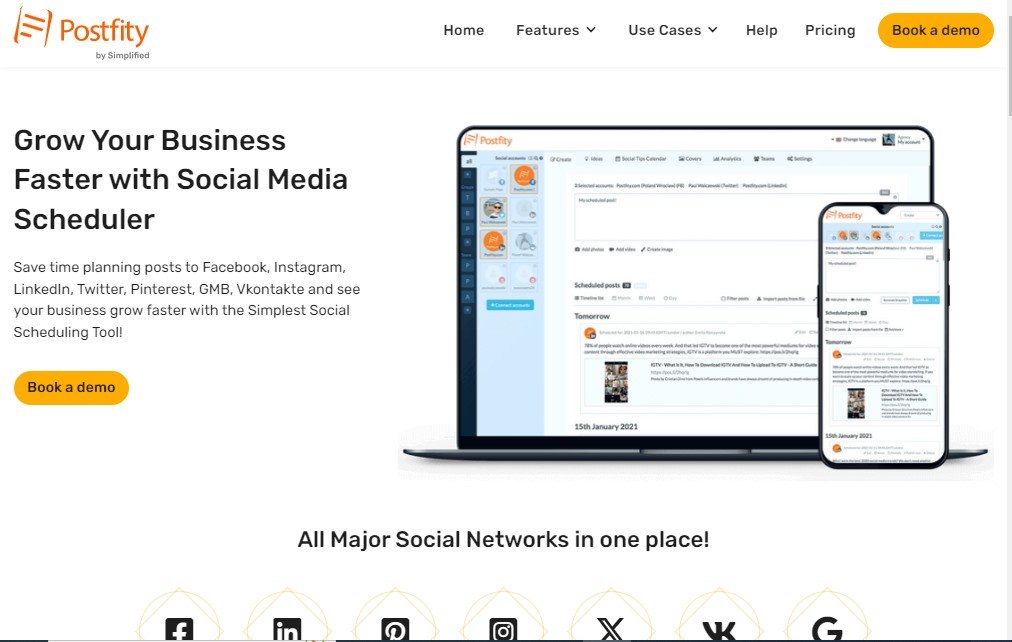I. Introduction to Success Stories in SaaS
In the competitive Software as a Service (SaaS) landscape, success hinges not just on a great product but on deploying innovative marketing strategies and deeply understanding the audience. As new competitors continuously enter the market, SaaS companies must excel in both attracting and retaining customers.
This article explores the strategies of five successful SaaS companies—Postfity, Chanty, Salesforce, Slack, and Shopify. Each has effectively used techniques ranging from precise content marketing and SEO optimization to customer-centric product innovations and community engagement, demonstrating substantial growth and leadership in their domains.
For entrepreneurs, CMOs, and marketers in the SaaS industry, these narratives offer more than inspiration; they provide actionable insights and strategies applicable to your growth efforts. Join us as we delve into each company’s approach, highlighting the decisive actions they took, the obstacles they overcame, and the remarkable results they achieved. These stories are not merely about celebrating success—they are about understanding the steps to replicate these achievements in your own business ventures.
II. Postfity’s Strategic Content Marketing and Outreach

Background
When Emilia Korczynska joined Postfity in early 2019, she found a social media automation platform with stagnant monthly recurring revenue (MRR) of around $5,000, due to a previously disjointed marketing strategy.
Strategy Implementation
Korczynska initiated a comprehensive revamp of Postfity’s marketing efforts, starting with a series of 12-week content sprints. These sprints targeted low keyword difficulty (KD) niches such as language schools and virtual assistant businesses, focusing on creating and promoting content that directly addressed the needs and interests of these specific audiences. The strategy was complemented by robust social media and email marketing funnels, along with increased guest posting and link-building efforts to enhance SEO and drive organic traffic.
Results and Key Takeaways
The streamlined and targeted approach led to a doubling of site traffic and a significant MRR increase to $10,000 within eight months. This success demonstrated the effectiveness of a well-coordinated content strategy that aligns closely with audience targeting and engagement. Postfity’s experience underscores the importance of precise content targeting and strategic outreach for SaaS companies aiming to boost both visibility and financial performance.
The key takeaways – How to put Postfity’s strategy in motion :
- Content Strategy:
- 12-week content sprints focusing on low keyword difficulty (KD) keywords within specific niches.
- Targeted niches included promoting language schools and virtual assistant businesses.
- Goal: Engage specific audiences strategically through tailored content.
- Marketing Funnels:
- Social media and email marketing funnels designed to capture and nurture leads from content.
- Guest posting and link-building targeting high domain authority sites to boost SEO.
III. Chanty’s SEO-Driven Market Entry

Background
Chanty entered a market dominated by well-established competitors like Slack, necessitating a cost-effective strategy to carve out its niche in the crowded SaaS communication space.
Strategy Implementation
To maximize its limited marketing budget, Chanty, led by Content Marketing Manager Mile Živković, adopted a robust SEO strategy from the outset. This approach included creating high-quality, search-optimized content targeted at specific queries frequently searched by potential users of team communication tools. The team also capitalized on referrals and word-of-mouth marketing to enhance their reach and credibility without significant ad spend.
Results and Key Takeaways
Chanty’s focused SEO efforts paid off, attracting 70% of their user base organically and establishing a strong market presence. This success highlights the effectiveness of a well-executed SEO strategy that leverages both content quality and strategic keyword targeting, proving especially valuable for new entrants in competitive markets.
The Key takeaways – How to put Chanty’s strategy in motion :
- SEO Focus:
- High-quality content creation optimized for search engines to resonate with the target audience.
- Keyword research to identify competitive opportunities in team communication queries.
- Community Engagement:
- Utilized referrals and word-of-mouth marketing to spread platform awareness cost-effectively.
IV. Salesforce’s Evolutionary Marketing Strategy

Background
Salesforce entered the CRM market with a revolutionary idea: delivering software over the internet through a simple subscription model, disrupting the traditional on-premise software installation method.
Strategy Implementation
Salesforce’s approach was centered around creating a minimum viable product (MVP) that was user-friendly and scalable. The company focused on ease of use and a pricing model that allowed businesses to start small and expand as needed, which attracted a broad range of customers from various industries. Emphasizing customer success, Salesforce implemented robust support systems to ensure that clients could easily implement and see the value of the CRM system, fostering rapid adoption and customer loyalty.
Results and Key Takeaways
This customer-centric and flexible approach led to exponential growth for Salesforce. It significantly expanded its product offerings beyond the initial CRM solution, continuously adapting to the evolving needs of its user base. Today, Salesforce boasts a global customer base and has achieved remarkable revenue growth, demonstrating the effectiveness of combining technological innovation with a strong focus on customer satisfaction and scalability. Salesforce’s strategy illustrates how SaaS companies can achieve long-term success and industry leadership through innovation and a commitment to customer success.
This section aims to highlight Salesforce’s strategic decisions and their impact on its growth and the broader CRM market.
V. Slack’s Community and Product-Centric Approach

Background
Launched in 2013, Slack revolutionized workplace communication, challenging traditional tools with its user-friendly and integrative platform.
Strategy Implementation
Slack’s key to success was its product-centric approach combined with a community-driven growth strategy. The platform was meticulously designed for ease of use, integrating with numerous apps to enhance functionality and user engagement. Slack also utilized a freemium model, allowing teams to experience the platform’s core benefits for free, with compelling premium features available for upgrade.
Results and Key Takeaways
This strategy quickly built a large, dedicated user base, resulting in rapid growth. By focusing on product excellence and leveraging organic marketing through user satisfaction, Slack not only grew its paying customer base to over 169,000 but also achieved a significant revenue increase, leading to a $28 billion acquisition by Salesforce. Slack’s success underscores the power of a product-led growth strategy, where exceptional user experience and strategic pricing are key drivers of adoption and expansion.
The Key Takeaways – How to put Slack’s strategy into practice :
- Product Experience:
- User-friendly design encouraging daily engagement.
- Hundreds of app integrations enhancing platform utility.
- Freemium Business Model:
- Free tier for basic needs with compelling reasons to upgrade.
- Community-driven growth strategy utilizing word-of-mouth.
VI. Shopify’s E-commerce Revolution

Background
Shopify has transformed e-commerce by making it accessible to anyone, regardless of technical skill, bridging the gap between complex enterprise solutions and basic do-it-yourself platforms.
Strategy Implementation
Shopify’s strategy focused on simplifying the setup and management of online stores with an intuitive user interface that facilitated rapid onboarding. The platform supported this with robust customer service and a dynamic app ecosystem that encouraged customization and growth.
Results and Key Takeaways
This approach propelled Shopify to the forefront of e-commerce platforms, supporting over one million merchants and achieving a 57% revenue increase in 2021 to $4.6 billion. Shopify’s success highlights the effectiveness of a user-centric design and an ecosystem that fosters continuous innovation and scalability.
The Key Takeaways – How to put Shopify’s strategy into practice :
- Product Experience:
- User-friendly design encouraging daily engagement.
- Hundreds of app integrations enhancing platform utility.
- Freemium Business Model:
- Free tier for basic needs with compelling reasons to upgrade.
- Community-driven growth strategy utilizing word-of-mouth.
VII. Closing thoughts
As we’ve explored the strategies and successes of Postfity, Chanty, Salesforce, Slack, and Shopify, a common thread emerges: each company’s ability to innovate and tailor their approach to meet the unique demands of their market. These stories illustrate not just the potential for growth within the SaaS industry but also the diverse pathways to achieving that growth. Whether through targeted content marketing, SEO mastery, revolutionary product design, community engagement, or democratizing technology, these companies have each carved out their own piece of the market, demonstrating the versatility and dynamism of the SaaS model.
Recap of Key Strategies:
- Postfity leveraged niche-targeted content sprints and strategic outreach to double its traffic and MRR, emphasizing the importance of precise market targeting.
- Chanty utilized SEO effectively to compete in a market dominated by giants, showcasing how strategic content and organic search can level the playing field for new entrants.
- Salesforce pioneered a customer-centric product that could scale with customer needs, proving that flexibility and ease of use are critical in SaaS.
- Slack focused on creating a product that users love, supported by a freemium model that facilitated widespread adoption and growth.
- Shopify made it easy for anyone to enter the e-commerce space, supporting them with a robust support system and a flexible platform that encourages growth and innovation.
As we wrap up our exploration of these SaaS success stories, it’s clear that whether it’s through innovative marketing strategies, user-centered product design, or scalable business models, companies like Postfity, Chanty, Salesforce, Slack, and Shopify have not only met the challenges of the digital age but have thrived within them. Each story serves as a testament to the power of understanding and responding to the needs of users—not just as customers but as community members and partners in growth.


